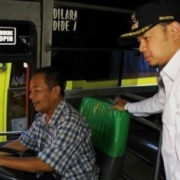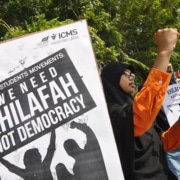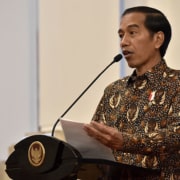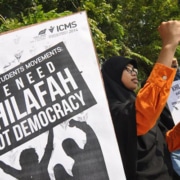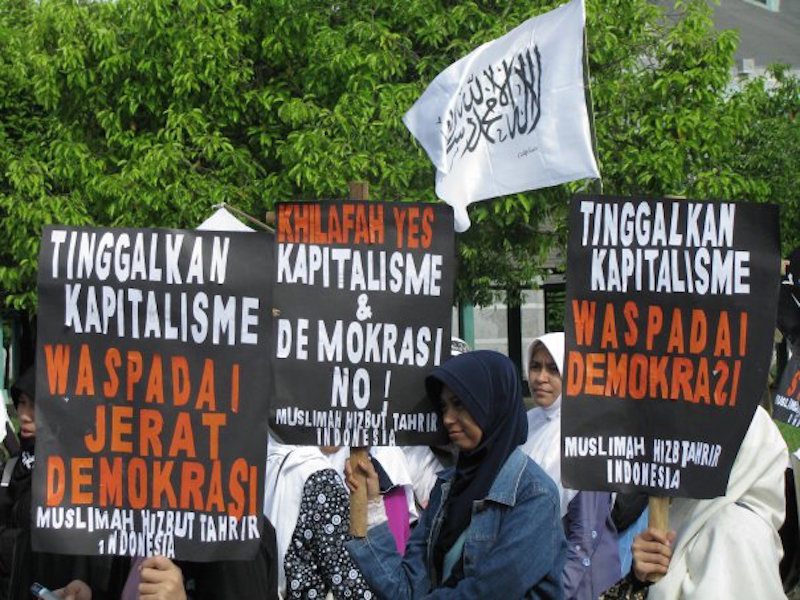
Indonesians were stunned that a state official would attend an event held by Hizbut Tahrir Indonesia, which openly rejects democracy. Photo by Syamsul Rijal.
Bogor Mayor Bima Arya Sugiarto shocked Indonesia when he inaugurated the new Hizbut Tahrir Indonesia (HTI) office in the city on 8 February. In an image that went viral, Bima was seen speaking at a podium, backed by HTI flags, with the Indonesian flag and framed pictures of president and vice president – standard in most public buildings in Indonesia – nowhere to be seen. This should not have come as a surprise. Like its counterparts around the globe, the Indonesian branch of Hizbut Tahrir states that its primary goal is the resurrection of a global caliphate. It rejects the nation-state, including its symbols, like Pancasila and the 1945 Indonesian Constitution.
The fact that HTI’s new office was located in Bogor was no coincidence. The transnational organisation first established a presence in Indonesia in the early 1980s through two influential Bogor-based figures: Abdurrahman al-Baghdadi and Mama Abdullah bin Nuh. As such, Bogor has long held a special place in the minds of HTI members, or hizbiyyin. This was especially the case during the formative stages of its struggle to revive an Islamic caliphate in Indonesia.
For many Indonesians, it was revealing that Bima Arya opened the office just a few months after his controversial circular banning the local Shi’a community from commemorating Ashura, which marks the martyrdom of the prophet Muhammad’s grandson, Hussein ibn Ali. The general view is that by openly supporting HTI, Bima Arya is playing the religion card for electoral purposes. Bogor is home to many conservative Muslims and it is argued that he needs a way to boost his waning approval rating after supposed failures in improving public service delivery.
This might be true, but it ignores important facts about HTI. Of the many Indonesian Islamist movements inspired by organisations in the Middle East, HTI is the only one that is fully controlled by a foreign leadership – a leadership that publicly rejects the idea of democracy and perceives elections as un-Islamic. Like other Hizbut Tahrir chapters elsewhere, HTI urges non-participation (golput) in elections for all of its followers. What does Bima Arya get out of approaching a radical organisation whose ideological framework explicitly denounces elections as the system of infidels?
The majority of Islamic activists in Indonesia, including members of the Prosperous Justice Party (PKS), for example, view HTI’s thoughts and methods (al-fikrah wa al-thariqah) as unrealistic and harsh. Unlike HTI, PKS and its supporters are political realists. The party accepts Indonesia as the nation-state and pursues its religio-political ends through the democratic electoral system. HTI and PKS have long had an uneasy relationship, extending back to their time as campus-sponsored religious groups in the 1980s. If Bima Arya was really attending the HTI event to garner electoral support it was not a wise strategy. Not only did he alienate his core mainstream constituency, but potentially also a significant portion of the conservative base that he was trying to woo. Why court HTI when PKS supporters would be much more willing to show up at polling booths than hizbiyyin?
Bima Arya claimed that attending the event did not mean that he supported HTI, and, in fact, he had publicly stated that he disagreed with the organisation’s vision for a caliphate. It is possible that the mayor’s attendance at the HTI event was simply the result of carelessness – a rookie politician who has yet to develop skills in detecting the unseemly odours of politics. But surely a PhD holder in political science was not so naive as to not recognise the potential negative consequences of attending an event at such a notorious organisation. Whatever the case, it appears Bima Arya grossly underestimated the potential blowback. He was severely criticised for weeks. His previous reputation as one of a new generation of talented regional leaders and a pluralist (owing to his close association with Paramadina University, a champion of pluralism) is now damaged beyond repair.
Bima Arya’s presence at the HTI event was a success for the transnational group in that it was able to demonstrate that it had reach beyond the organisations or people who already publicly advocate for the imposition of Islamic law. This is an important component of HTI’s broader strategy. To revive a transnational Islamic caliphate, the founder of Hizbut Tahrir, Taqiuddin Al-Nabhani, proposed a three-stage program for what he terms an “Islamic peace revolution” . The first is a “culturing process” (marhalah al-tathqif) in which HTI cultivates people to believe in its thoughts and methods through training and mentoring. HTI focused on this first stage of indoctrination while operating as a clandestine organisation under Soeharto’s New Order, which suppressed political Islam.
After the fall of Soeharto in 1998, HTI seized the opportunity provided by greater civil liberties and emerged into public view. Following its international conference on the Islamic caliphate in 2000, HTI launched the second phase of its project, commonly referred to as the “interaction stage” or marhalah tafaʾul maʾa al-naas. In doing so, HTI sought to interact with a broader section of society and raise awareness about the need for an Islamic caliphate. After securing the support of a significant portion of the Muslim community, HTI will launch the final stage, istislam al-hukmi, the “taking” or “accepting” of power.
As described by the Hizbut Tahrir leadership, to build momentum toward the third phase, HTI supporters should seek nusrah (assistance to gain power) from important members of society, such as military figures, law enforcement officials, key political institutions, regional heads, and so on. According to HTI, pursuing nusrah is derived from the actions of Muhammad, who sought the support of influential people who would embrace Islam and willingly transfer authority to him during his hijrah (migration) from Mecca to Medina. Although this stage is non-violent, HTI does not explicitly repudiate the use of violence to achieve this goal.
HTI is now in this second stage, attempting to actively persuade prominent mainstream figures to improve its legitimacy. Bima Arya acknowledged that he had been approached by HTI since 2008, when he was still a political commentator. But Bima Arya is not the only person to be targeted. Another public figure reportedly approached by HTI is Adhyaksa Dault, the former Minister of Sports and Youth Affairs, who is now apparently considering running in the Jakarta gubernatorial race in 2017.
HTI has a systematic and organised strategy to implement its grand narrative of the resurrection of a transnational caliphate and its ambition to overthrow the nation-state and democracy. Ironically, it is benefiting from the current democratic political system, in which political rights are also granted to a group that clearly aims to end the regime of democracy.


